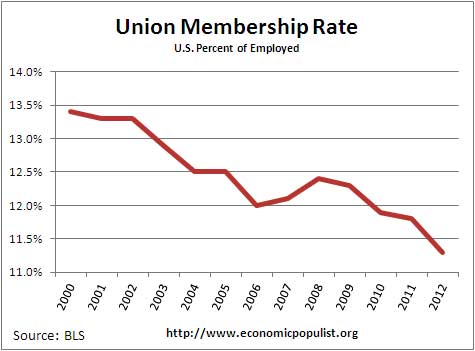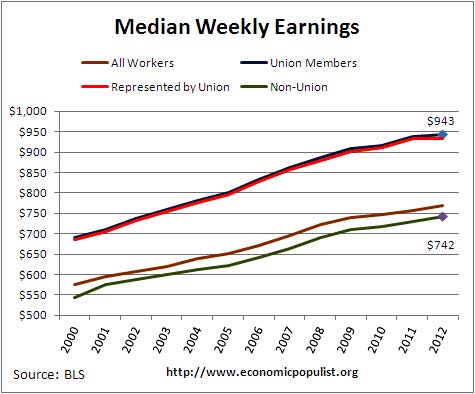The attack on unions has been clearly effective. America's workers who are members of a union declined by 0.5 percentage points in 2012 to a low of 11.3%. In 1983 20.1% of all workers were members of a union and in 2011 11.8% of America's employed were union members. We have not seen union membership rates this low since the Great Depression.

In 1932, before FDR's New Deal, union membership was 6.0%. After the FDR administration passed the National Labor Relations Act in 1935 to protect the rights of labor organization, union membership started to rise. By 1937 union membership was 12.9 %. America has just gone backwards in labor rights and organization
The BLS issued their annual union membership statistics and if it was ever more clear what a union can do for you it is wages. The wage difference between union members and non-union workers is huge. In 2012, the median weekly wage for workers not in a union was $742. Union members, on the other hand, had a median weekly wage of $943. That's a difference of $201 a week or $10,452 a year assuming one has paid vacation time and sick days, which many workers these days do not.

While there are occupational and regional differences in weekly wages, it is clear the right to collective bargain really makes a difference in obtaining a paycheck large enough to make rent with.
It is also clear why the Koch Brothers are busy getting their minions into public office. Private sector unions have already been decimated and the last hold out seems to be the public sector. Government, or public-sector workers have a 35.9% union membership rate. This is five times higher than the private sector, where only 6.6% of workers are in a union.
Union busting right to work laws have taken their toll as well. North Carolina, a right to work state, has only 2.9% union membership among those employed whereas New York, which does not have right to work laws, has a 23.2% union membership rate for those employed.
From the report:
Within the public sector, local government workers had the highest union membership rate, 41.7%. This group includes workers in heavily unionized occupations, such as teachers, police officers, and firefighters.
Private-sector industries with high unionization rates included transportation and utilities, 20.6%, and construction, 13.2%. Low unionization rates occurred in agriculture and related industries (1.4%) and in financial activities (1.9%).

The union membership rates hit a bad milestone
Unions and their growth is a main reason why the middle class grew from 1935-1980.
Maybe private unions need to remember their history
Before Gompers sold out the workers there were the Knights of Labor and IWW, Western Federation of Miners. Their goal was for workers to own and operate industry, knowing that they would never be given anything they weren't strong enough to take. Not Socialism or Communism, just working people owning and controlling their own jobs and assets.
But capitalists spent the equivalent of a billion dollars a year, according to an NLRB estimate during the LaFollette hearings, for finks, spies, and politicians. Between their efforts and the AFofL, they convinced a citizenry that these people who asked for an 8-hour day, unemployment, and and end to child labor were the enemy. At the same time the business owners were and had been killing working people by the thousands in pursuit of the dirtiest of profits, (same dirty profits today). And with the help of murders and torture by the American Legion, the police, the Ku Klux Klan, various state militias and Federal troops they stopped the movement toward freedom.
Maybe the unions have outlived their usefulness. When things are growing it's easier to get dues, to accept a small raise, to think somehow that because Mr. Charlie is giving back a few of the bucks he took from you in the first place that the union is doing their job. The AFL knew that, and tied the workers back onto the yoke of their Master far too cheaply.
But that's the problem with small vision.Unions have been overwhelmed with our current conditions, lost their leverage between outsourcing and technological changes. If they had stayed on the path of worker ownership they might have not only stayed relevant but turned into a resource. It's a resource that's sorely needed when your government is more interested in propping up the rich than worrying about increases in food stamps and millions more added to the roles of the "working poor". (I spoke with someone protesting the shutdown of a plant recently that is going to be shuttered. I asked what would happen when they were protesting in front of the empty building, and was told "We will move to the next one". Baby, that's a loss in anyone's book, and a slow, painful road downhill. Sad.).
United Steel Workers signed a deal a few months back with the Mondragon Cooperative, so maybe someone is learning.
I'd say it's clear unions have not
The difference between career stability, wages, benefits for those unionized and those not is obvious. One can argue some of their politics don't make sense and that's quite the turn off as are maybe some other things, but the wages, benefit disparities make it clear what happens without unions. As does the history of American labor. Outsourcing, globalization and frankly immigration (in spite of their position), have hurt unions as well as all workers. Race to the bottom on wages.